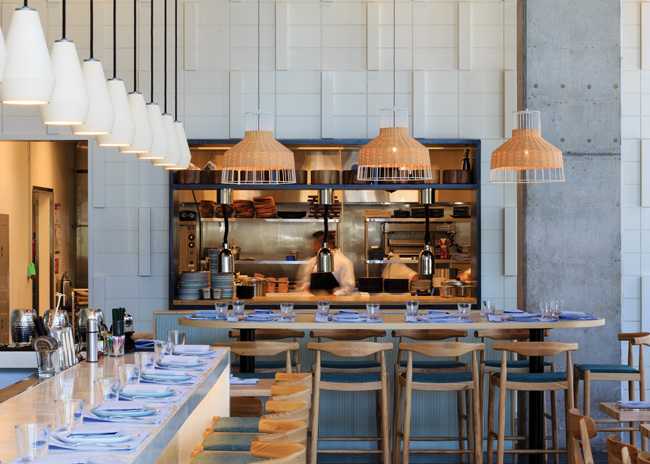The big focus when designing Pilina restaurant in the Fairmont Kea Lani hotel in Maui, Hawaii, was creating a sense of place, of an authentic Hawaii.
“We wanted guests to feel they were in Hawaii but also discover more about the culture and have it be accurate,” says Regan McLean, senior designer, Parker-Torres Design, Sudbury, Mass.
Authenticity and a sense of place is a very important part of hotel restaurant design with the goal to either immerse guests into the locality or to transport them to a completely different one.
Before even starting on the design of Pilina, McLean spent a lot of time creating a narrative for the restaurant that focused on Maui’s beauty, history and tradition. She was also fortunate that the hotel had a cultural advisory team with whom she worked closely to ensure everything — from the plants shown in paintings to the artists featured — were native to the island.
One of the standout features of Pilina is the deep reddish-brown monkey pod wood that runs through many design details. “Wood was the most important material — we didn’t add many other native Hawaiian materials because we wanted wood to be the primary element,” McLean says. “We wanted the richness of wood to be layered throughout and elements of detail beyond that to add richness.”
She knew local materials would be important, so worked closely with a millworker. “We wanted it to be native but also beautiful and work with our design,” says McLean. “The monkey pod has a beautiful graining and a nice color.”
Diners enter Pilina from the lobby, through a monkey pod archway and past a column covered with winding monkey pod planks. The column had to remain there, “and it worked really well with our overall concept,” McLean points out. “The wooden planks travel out across the space from the column, combining different areas.”
Pilina is a large space with different zones, broken up by furniture styles and colors to define separate areas.
The fabrics were all inspired by native designs and local plants. “We wanted to infuse a lot of color — greens as our base, then pops of orange and other colors that bring in the colors of the native vegetation of Hawaii,” McLean says.
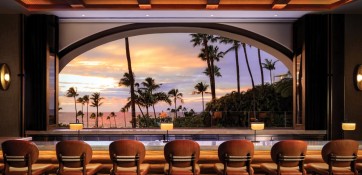
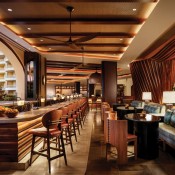

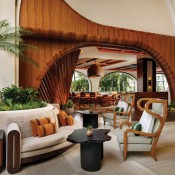

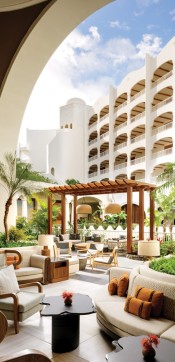
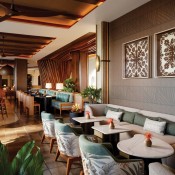
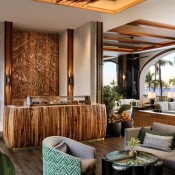
Native monkey pod wood has been used throughout Pilnia so guests truly feel they’re in Hawaii and can absorb its nature and culture. Images courtesy of Pilnia
Local artists created many of the elements of Pilina, including a large-scale custom carved wood piece above the sushi bar that depicts local flora, and three bespoke breadfruit quilts that were hand-stitched and appliquéd by a Hawaiian artisan, inspired by historical Hawaiian breadfruit patterns.
Planters are filled with native greenery. In fact, the placement of the plants offers a progression and history lesson as one moves through the space, starting with indigenous plants then plants that have been introduced over time “so it gradually builds up and embraces everything Hawaii, including introduced elements that Hawaii has taken and twisted into its own,” says McLean.
She wanted the space to feel traditional and authentic but also modern and fun. “We incorporated details like carved wood and authentic patterns to root the design in authenticity. We also used vibrant colors inspired by local flowers and dramatic sunsets, reflecting Maui’s landscape to infuse color in the space. We contrasted the traditional Hawaiian feel with modern forms in the furniture and lighting.”
McLean mixed the traditional with the contemporary wherever possible, for example framing the traditional breadfruit quilt in a modern metallic shadow box. Additionally, the wood column feature extends across the ceiling to the sushi bar.
The most authentic part of the entire design of Pilina is the spectacular view from the bar. The bar seating directly faces an arched window behind the bar. The window opens fully, accordian-style, to a view of the ocean, palm trees and the nightly sunset.
“We didn’t want a large back bar with bottles or TVs that would distract from the view,” says McLean. She didn’t even want any lights hanging over the bar to block the view, so the space features small lamps on the bar top and some custom sconces on columns.
McLean also created seating vignettes on the wall opposite the bar, so diners there would catch glimpses of the view as well. “You’re still part of the action but you have an intimate experience there too,” she says.
The vignettes break up the space, she points out. “We didn’t want a sea of chairs, so wherever you look you are uncovering new details, new patterns, that work together but there are nice surprises through the space. We wanted the focus to be on the sunset, but we didn’t want stadium seating with everyone facing the windows.”
McLean wanted Pilina to both stand out and blend in with the hotel. “We carried the finishes and design language from the lobby and [nearby] cultural center into the bar to maintain an authentic Hawaiian feel. However, we wanted Pilina to feel more intimate, with lower ceilings and large openings to the exterior, making it an extension of the landscape. The space features a lot of greenery among the seating and many opportunities to take in the breathtaking view.”











